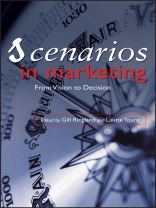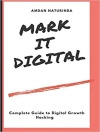You’ve chosen this book. Which probably means you’re a marketer,
you’ve heard of scenarios and you want to know what they can do for
you. Can they help with everyday marketing issues like brands,
channels and relationships? The answer is yes. Rooted in customer
needs, scenarios bridge the gap between corporate strategy and
marketing tactics. They are a weapon for perceiving the unseen and
a framework for thinking the unthinkable. This book’s wealth of
case studies will show you how they’ve helped top companies like
Pfizer, Nestle and Courvoisier to do just that, and its practical
lessons will show how they can do exactly the same for you.
Gill Ringland and Laurie Young have gathered top-flight
contributors to offer the first straightforward account of scenario
planning for marketers. In readable chapters they show how, by
integrating scenarios into the wider marketing toolkit, you can
make your organization more customer-driven and consider a wider
range of possibilities than your competitors. They explore how
scenarios have driven creativity in a range of consumer marketing
applications – even in FMCG sectors – and define their role in
distribution, channel management, brand management and customer
management strategy. Finally, they show how marketing scenarios can
help to promote wider corporate innovation.
The rich pictures painted by scenarios have made business
strategy more visionary and creative, and they’re set to do the
same with marketing strategy. Read this book, and make sure it’s
your organization holding the brush.
Table of Content
List of Figures vii
List of Tables ix
Contributors xi
Acknowledgements xv
Chapter 1 Introduction to Scenario Planning 1
Gill Ringland
Chapter 2 Securing Future Revenue 19
Laurie Young
Chapter 3 Marketing Strategy and Scenarios 45
Paul Fifield
Chapter 4 Scenario Planning and Innovation 61
Tim Westall
Chapter 5 Scenarios in Customer Management 83
Merlin Stone and Neil Woodcock
Chapter 6 Scenarios in Brand Valuation and Brand Portfolio Strategy 101
David Haigh
Chapter 7 Marketing Communication: Radical or Rational Change? 119
Don E. Schultz
Chapter 8 Scenarios for Fast-Moving Sectors 139
Andrew Curry, Lloyd Burdett and Crawford Hollingworth
Chapter 9 Conclusions 159
Appendix 1 Building Scenarios 161
Appendix 2 Marketing Tools and their Use with Scenarios 169
Appendix 3 A History of Scenarios 207
Index 217
About the author
About the authors
Gill Ringland is an expert in scenario planning. After research at the University of California, Berkeley and as a Fellow at Somerville College, Oxford, Gill had a career in the IT industry. As Head of Strategy at ICL, she used scenarios to understand the complexities of the information and communications industry and map ICL’s future. Since 2002, Gill has written and consulted widely as Fellow and Chief Executive of St. Andrews Management Institute (SAMI). She is the author of three previous books – Scenario Planning (now in its Second Edition), Scenarios in Business and Scenarios in Public Policy – all published by Wiley.
Laurie Young is a specialist in the marketing of services and customer care. His career includes senior positions with Pricewaterhouse Coopers, BT and Unisys. In the 1990s he founded, built and sold his professional services company specialising in services marketing. Over the years he has advised a number of major international blue-chip organisations on the contribution of services marketing programmes to shareholder value. He is the author of Marketing the Professional Services Firm, also published by Wiley.












